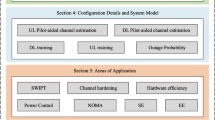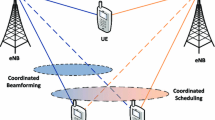Abstract
This work presents solutions to enhance the performance of urban cellular networks based on Multiple-Input Multiple-Output (MIMO) systems. First, some adjustments to the Base Stations (BSs) are proposed and evaluated, namely the reorientation of the antennas and two new placements of the BSs, while maintaining or even diminishing the number of required BSs. Afterwards, a cooperative wireless system is combined with a relay selection scheme, also proposed here, and its performance is assessed; this scheme allows to exploit the MIMO spatial multiplexing gain in a distributed and simple manner. This study is performed for a realistic urban environment, i.e., using a simulator that incorporates realistic underlying models (test environment, mobility and radio propagation models), and it is envisioned for market available technology, such as Long Term Evolution (LTE) and Bluetooth. The simulation results show that not only all the proposed placements of the BSs present a superior performance with respect to the traditional placement, but also the relay selection scheme, when incorporated in the cooperative system, can be a valid approach to increase the MIMO channel capacity.








Similar content being viewed by others
References
3GPP. (2013). Evolved universal terrestrial radio access (E-UTRA); User equipment (UE) radio transmission and reception (Release 8). Technical Specifications 36.101, v. 8.23.0.
Vieira, P., Queluz, M. P., & Rodrigues, A. (2008). Improving MIMO spectral efficiency in 4G macro-cellular networks. In 2nd URSI Seminar of the Portuguese Committee. Lisbon, Portugal.
Sauter, M. (2010). From GSM to LTE: An introduction to mobile networks and mobile broadband. New York: Wiley.
Foschini, G. J., & Gans, M. J. (1998). On limits of wireless communications in a fading environment when using multiple antennas. Wireless Personal Communications, 6, 311–335.
Telatar, E. (1999). Capacity of multi-antenna Gaussian channels. European Transactions on Telecommunications, 10(6), 585–595.
3GPP. (1998). Selection procedures for the choice of radio transmission technologies of the UMTS. Technical Report 30.03, v. 3.2.0.
Li, X., & Nie, Z. P. (2004). Effect of array orientation on performance of MIMO wireless channels. IEEE Antennas and Wireless Propagation Letters, 3, 368–371.
Abouda, A. A., El-Sallabi, H. M., & Häggman, S. G. (2006). Effect of antenna array geometry and ULA azimuthal orientation on MIMO channel properties in urban city street grid. Progress in Electromagnetics Research, 64, 257–278.
Sousa, I., Queluz, M. P., & Rodrigues, A. (2013). MIMO Channel Capacity Spatial Distribution in a Microcell Environment. In 2013 IEEE Wireless Communication & Networking Conference (pp. 3197–3202). Shanghai, China.
Sendonaris, A., Erkip, E., & Aazhang, B. (2003). User cooperation diversity. Part I. System description. IEEE Transactions on Communications, 51(11), 1927–1938.
Sendonaris, A., Erkip, E., & Aazhang, B. (2003). User cooperation diversity. Part II. Implementation aspects and performance analysis. IEEE Transactions on Communications, 51(11), 1939–1948.
Laneman, J. N., Tse, D. N. C., & Wornell, G. W. (2004). Cooperative diversity in wireless networks: Efficient protocols and outage behavior. IEEE Transactions on Information Theory, 50(12), 3062–3080.
Wang, B., Zhang, J., & Host-Madsen, A. (2005). On the capacity of MIMO relay channels. IEEE Transactions on Information Theory, 51(1), 29–43.
Bolcskei, H., Nabar, R. U., Oyman, O., & Paulraj, A. J. (2006). Capacity scaling laws in MIMO relay networks. IEEE Transactions on Wireless Communications, 5(6), 1433–1444.
Fan, Y., & Thompson, J. (2007). MIMO configurations for relay channels: Theory and practice. IEEE Transactions on Wireless Communications, 6(5), 1774–1786.
Liu, P., & Panwar, S. (2009). Randomized spatial multiplexing for distributed cooperative communications. In 2009 IEEE Wireless Communication & Networking Conference (pp. 1646–1651). Budapest, Hungary.
Sousa, I., Queluz, M. P., & Rodrigues, A. (2013). A smart scheme for relay selection in cooperative wireless communication systems. EURASIP Journal on Wireless Communications and Networking, 2013(1), 1–13.
Clarke, P., & de Lamare, R. C. (2012). Transmit diversity and relay selection algorithms for multirelay cooperative MIMO systems. IEEE Transactions on Vehicular Technology, 61(3), 1084–1098.
Ding, M., Liu, S., Luo, H., & Chen, W. (2010). MMSE based greedy antenna selection scheme for AF MIMO relay systems. IEEE Signal Processing Letters, 17(5), 433–436.
Damosso, E., & Correia, L. M. (1999). COST action 231: Digital mobile radio towards future generation systems: Final report. European Commission.
Almers, P., Bonek, E., Burr, A., et al. (2007). Survey of channel and radio propagation models for wireless MIMO systems. EURASIP Journal on Wireless Communications and Networking, 2007(1), 1–19.
Abouda, A. A., & Häggman, S. G. (2006). Effect of mutual coupling on capacity of MIMO wireless channels in high SNR scenario. Progress in Electromagnetics Research, 65, 27–40.
Shimazu, Y., Ohyane, H., Watanabe, T., Yajima, T., & Suwa, S. (2011). LTE base station equipments usable with W-CDMA system. NTT DOCOMO Technical Journal, 13(1), 20–25.
Khan, F. (2009). LTE for 4G mobile broadband: Air interface technologies and performance (1st ed.). New York, NY: Cambridge University Press.
3GPP. (2013). Evolved universal terrestrial radio access (E-UTRA); Requirements for support of radio resource management (Release 8). Technical Specifications 36.133, v. 8.23.0.
Zurbes, S., Stahl, W., Matheus, K., & Haartsen, J. (2000). Radio network performance of Bluetooth. In 2000 IEEE International Conference on Communications (Vol. 3, pp. 1563–1567). New Orleans, LA, USA.
Sousa, I., Queluz, M. P., Rodrigues, A., & Vieira, P. (2011). Realistic mobility modeling of pedestrian traffic in wireless networks. In IEEE EUROCON 2011 - International Conference on Computer as a Tool. Lisbon, Portugal.
Sousa, I., Queluz, M. P., & Rodrigues, A. (2012). Implementation of the COST 273 directional channel model in microcell scenarios. In 9th International Conference on Wireless Information Networks and Systems. Rome, Italy.
Berg, J. E. (1995). A recursive method for street microcell path loss calculations. In 6th IEEE Personal, Indoor and Mobile Radio Communications Symposium (Vol. 1, pp. 140–143). Toronto, ON, Canada.
Tse, D., & Viswanath, P. (2005). Fundamentals of wireless communication. Cambridge: Cambridge University Press.
Love, D. J., Heath, R. W., Lau, V. K. N., Gesbert, D., Rao, B. D., & Andrews, M. (2008). An overview of limited feedback in wireless communication systems. IEEE Journal on Selected Areas in Communications, 26(8), 1341–1365.
Correia, L. M. (2006). Mobile broadband multimedia networks: Techniques, models and tools for 4G. London: Academic Press.
Marcus, M., & Minc, H. (1992). A survey of matrix theory and matrix inequalities. New York: Dover.
Acknowledgments
This work was funded by Instituto de Telecomunicações/LA, by Instituto Superior Técnico under a postdoctoral grant (BL2/2015) and by FCT (Foundation for Science and Technology) under project UID/EEA/5008/2013.
Author information
Authors and Affiliations
Corresponding author
Rights and permissions
About this article
Cite this article
Sousa, I., Queluz, M.P. & Rodrigues, A. Boosting MIMO Systems Performance in Urban Cellular Networks. Wireless Pers Commun 95, 723–741 (2017). https://doi.org/10.1007/s11277-016-3794-7
Published:
Issue Date:
DOI: https://doi.org/10.1007/s11277-016-3794-7




